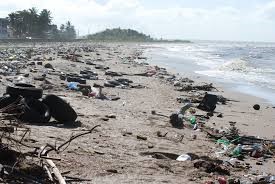An ominous exclusion to commercial general liability insurance
Water is essential to life and no human can survive without it. However, Water Pollution abounds making clean water a rare commodity throughout the world although America is considered a water rich country compared to many other countries. Unfortunately, stewardship of this precious resource has not always been successful in the United States. Even though knowledge is gained exponentially as more research is conducted, more people become aware of the issue and more efforts are aimed at protecting water. Yet Water Pollution still occurs every day in the business world. This is not an exaggeration.
Water Pollution is not limited to major industry and manufacturing.
Even SMB’s have wastes that eventually reach the water. Beauty shops use chemicals dyes and bleaches which end up in the sewer system. Day cares use diapers, bleach, wipes and pharmaceuticals. Schools use bleaches, pesticides and cleaning products, Family farmers, as well as farming conglomerates, use fertilizer, feed, herbicides and pesticide. Farm animals give off waste which result in methane and pollutants in the water. Auto repairs, lawn mowing, painting all use products with pollutants which seep into our land and waters. Additional pollution comes from bacteria in the water. The list goes on and on. Essentially “…water and air have become global garbage cans” Jacques Yves Cousteau.

Water Pollution Insurance coverage is a critically necessary to protect many businesses from liability and loss of their assets.
Water Pollution is a form of environmental pollution, which is often excluded from commercial general liability insurance in present day. Prior to 1980, comprehensive general liability did include environmental pollution liability in some states. It is entirely possible to have a claim brought for environmental pollution and find that an older general liability policies may still cover the event where the pollution has been ongoing over a lengthy period of time. (This is a very complex issue under insurance law which is beyond the scope of this article and consultation with a qualified attorney is advisable if you find yourself embroiled in a lawsuit or you have been notified of a claim).
Businesses and government usually want to protect their employees, their clients, their community and ultimately the end consumers of water. But businesses, local governments and the federal government make mistakes which affect everyone in the immediate area. For instance think of the water pollution issues arising in Flint, Michigan when the city sought a cheaper water resource and did not explore the risks beforehand.
All sorts of circumstances can arise where businesses pollute the water unknowingly, or were unaware of the health consequences; or even polluted knowingly but did not have the information, resources or ability to prevent the pollution. This scenario is all to plausible when any business is seeking to reign in costs.So what can you do to protect your business and assets from liability for pollution if you are in a precarious position or just want to help?
Businesses should ask the following questions before making business or financial decisions which may negatively affect clean water.
- What possible impact does my particular business have on pollution of the waterway? (Assess you specific situation).
- What products to do you use which contain pollutants?
- How do you dispose of your pollutants?
- Is the disposal process environmentally safe?
- Are any of the byproducts carcinogens, endocrine disputing compounds, heavy metals or toxins?
- Are my employees adversely affected by exposure to these toxins?
- How can I stop pollution or at least reduce my impact? Suggestions are:
- Recycle office and industrial byproducts when possible
- Prevent runoff of wastewater contaminated by industrial pollutants
- Use water efficient processes where possible in the office. For example low flow toilets and automatic sinks for employees
- Use water efficient processes and water purification in your day to day operations.
- Do not dump untreated toxic substances produced as a result of your business processes into any water source
- Prevent chemical leaks and spills
- Ensure sewage is treated or and sent to the proper facility for sanitation
- Work with your agent, carrier and risk management to establish safety plans
These are but a few ideas you can implement. Research your specific industry for available solutions, filtration systems, less toxic alternatives and products you can use to cleanse and decontaminate waters used in your business processes. Some online resources are: National Institute of Environmental Health Sciences, www.nies.nih.gov., Water Research Foundation, www.water.org, Water Online, www.wateronline.com and Pollution Online, www.pollutiononline.com. Also see and ISO 14001: 2004 & 20015.
If environmental pollution is excluded under your policy, which is very likely, your options are standalone policies, supplements and endorsements to your general liability policy or your business owner’s package. Your agent may have to obtain a policy from a specialty broker, e.g. Lloyd’s. Environmental pollution insurance has many nuances and one type does not fit all. Business owners need to be sure that you obtain the insurance you need to cover specific situations;for example, run off of waste water versus pouring chemicals into a river or waterway. Either or both can be excluded depending on the verbiage of your individual policy.
Proactive steps to obtain water pollution insurance may benefit your business
Additionally, you may receive tangible benefit from taking proactive steps such as receiving discounts and rate decreases from your carrier when you implement Water Pollution controls and safeguards which protect your employees and the public. Positive accolades, public support and recognition often follow proactive actions which can be used for marketing programs.
This blog post is not intended to be or to convey legal advice. All material and information have been created for general insurance informational purposes only, and should not be acted upon or accepted as legal advice and is not a substitute for obtaining legal advice from an attorney of your choosing.
Image Credit. Google Images: JPEG Image used under an Advance Search license free to share for commercial usage.